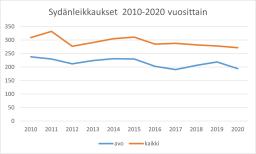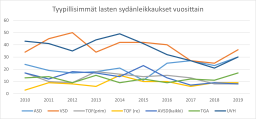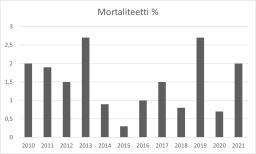Treatment results for children with heart conditions
New Children’s Hospital manages all pediatric heart defects. Cardiac surgery, heart catheterizations, and heart transplantations in children have been centralized nationwide at New Children’s Hospital. The monitoring of children’s pacemakers that are remotely monitored and demanding imaging studies, such as MRI examinations of patients with univentricular heart defects, is also centralized at HUS. Our treatment results are as high as those of the best pediatric hospitals in Europe.

We perform approximately 250–300 pediatric heart surgeries every year. Two-thirds of the surgeries are open-heart surgeries and about one-third are so-called closed-heart surgeries. More than half of the children operated on are under one year in age and just over a quarter are less than a month old. Approximately 30% of children’s heart surgeries are repeat operations. The share is high, as some heart conditions need to be treated step by step or as the child grows. We perform approximately four heart transplants each year.
About 4,500 patients visit a pediatric cardiologist every year. We perform more than 300 procedures in the catheterization laboratory.
Most heart defects in children are diagnosed in routine postnatal follow-ups. The most severe heart defects are most often found in structural ultrasound examinations performed already during pregnancy, in which case the delivery of the baby is referred to the HUS Women’s Hospital. During the monitoring, we plan the treatment path in advance of the child’s birth.
A prerequisite for the best possible treatment is multi-professional cooperation. We have all the modern research and treatment practices at our disposal. The treatment of a surgical patient is planned in cooperation with pediatric cardiac surgeons and cardiologists. Surgical treatment is carried out in collaboration with pediatric cardiologists, pediatric cardiac surgeons, and pediatric anesthesiologists. Our other staff are also specialized in the care of a pediatric heart patient.
When a child arrives at the hospital, their previous findings are checked clinically, using cardiac ultrasound and, if necessary, other imaging methods. On the morning of surgery, the child’s findings and surgical plan are reviewed with the operating room staff and the surgical result is checked with ultrasound and, if necessary, using angiocardiography.
More and more often, patients can undergo a procedure without actual heart surgery. In this case, the operation is performed through a blood vessel in a catheterization laboratory. Corrective procedures include, for example, the dilatation of the outflow valve and the closure of an atrial septal defect that overloads the heart or a patent ductus arteriosus remaining from the fetal period. Certain arrhythmias that cause rapid heart rate frequencies can also be treated by vascular routes. Treatment times and recovery after these procedures are shorter than after a heart surgery.
We are part of ERN GUARD-Heart’s network of experts on rare heart diseases.
Our treatment results
Our treatment results are at the same high level as the best pediatric hospitals in other Nordic countries and Europe. The long-term prognosis after surgical treatments is excellent in almost all the diagnostic groups. This requires constant monitoring of patients by pediatric cardiologists at outpatient clinics dedicated to the treatment of congenital heart defects.
The improvement in the long-term prognosis of children who have undergone heart surgery has been influenced by the development of all aspects of treatment: diagnostics, surgical methods, anesthesia and intensive care during and after surgery, and follow-up monitoring. The development of treatment can be seen especially in the treatment of complex heart defects, and the prognosis for the treatment of univentricular heart defects, which require surgery in stages, has also improved significantly, although the long-term prognosis is still weaker than in other heart defects.

The table shows the number of heart surgeries performed at HUS’s New Children's Hospital in 2010–2020. The orange curve shows the total number of heart surgeries and the blue curve shows the proportion of open-heart surgeries. The majority of surgeries, about two-thirds, are open-heart surgeries. One third of children’s heart surgeries are so-called closed-heart surgeries.

The most common operated heart defects are VSD (ventricular septal defect), aortic coarctation, Fallot’s tetralogy (TOF), transposition of the great arteries (TGA), and univentricular heart defect (UVH). Although most atrial septal defects (ASD) are now closed in the cardiac catheterization laboratory, ASD surgery is still the most common surgery.

As a result of the centralization of the treatment of pediatric heart conditions, surgical mortality has decreased from about 8% in the 1990s to about 1.5% today, which is below the average of the European heart surgery registry, despite the fact that even the most severe heart defects can now be treated surgically.